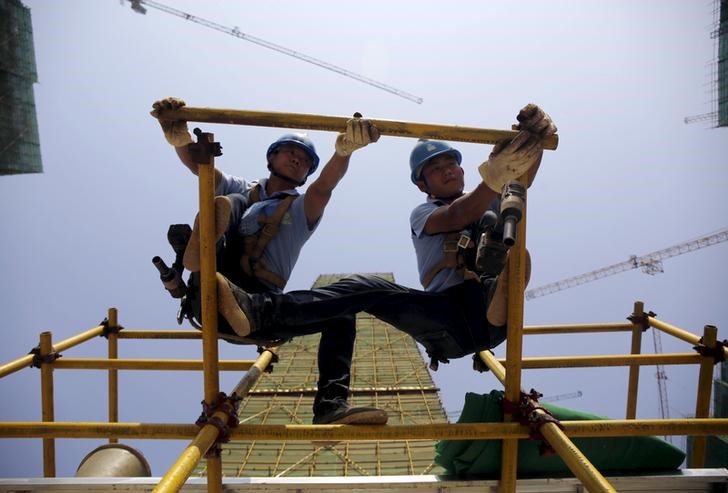BEIJING (Reuters) - A deluge of data from China in coming weeks is likely to point to further weakness in the world's second-largest economy, reinforcing expectations that Beijing will roll out more stimulus measures to ward off a sharper slowdown.
September performance readings will be capped by third-quarter gross domestic product (GDP) on Oct. 19, with many economists expecting growth to drop below 7 percent, the weakest since the global financial crisis.
Some investors fear the economy is at risk of a hard landing which could jeopardise an increasingly fragile international outlook, though most analysts forecast a slow deceleration, predicting that a raft of earlier support measures will gradually kick in.
A summer stock market crash does not appear to have hurt the economy as much as earlier feared, but the central bank is still struggling to stabilise the yuan currency after its surprise devaluation in August and investors continue to pull capital out of the country.
China's exports and imports likely declined at a faster pace after a dismal August, according to Reuters polls, while growth in factory output and investment may have weakened further, reflecting persistent weakness in demand at home and abroad.
Exports were expected to have dropped 6.3 percent in September after sliding 5.5 percent in August, in further evidence that a chill is falling over the global economy.
Imports may have declined 15 percent in September from a year earlier, following a 13.8 percent drop in August that reflected sluggish domestic demand and lower commodity prices, the median forecast of 30 analysts polled by Reuters showed.
That may produce a trade surplus of around $46.8 billion.
China's combined exports and imports fell 7.5 percent in the first eight months of the year from the same period in 2014, well below the official full-year growth target of 6 percent.
Factory output likely grew 6.0 percent in September year-on-year, slowing from August's 6.1 percent rise, as firms struggle to cope with persistent deflationary pressures due to overcapacity and softening demand.
Activity in China's factory sector shrank again in September as new orders dwindled, private and official surveys showed earlier this month, fuelling fears that the economy may be cooling more rapidly than expected.
Annual growth of fixed-asset investment, a crucial driver of China's economy, likely eased to 10.8 percent in the first nine months of 2015 - the weakest expansion in nearly 15 years - from 10.9 percent in January.
Annual retail sales growth was seen at 10.8 percent in September, unchanged from the previous month.
The Reuters poll also showed China's consumer price inflation may have slowed to 1.8 percent in September from 2.0 percent in August, while producer prices fell 5.9 percent, the same rate as in the previous month and the worst since the global financial crisis.
In what could be the lone bright spot in the data, banks likely made 885.5 billion yuan ($139.57 billion)in new loans in September, up sharply from 809.6 billion yuan in August, as loan demand improves due to quickening government approval of infrastructure projects.
M2 money supply is seen growing 13.2 percent in September from a year earlier, easing from August's 13.3 percent rise.
The government is aiming for economic growth of around 7 percent this year, down from 7.3 percent in 2014 and the weakest pace in a quarter of a century.
Some analysts believe current growth levels are already much weaker than official data suggest, and say Beijing's handling of a stock market rescue and its foreign exchange market has undermined confidence in its ability to manage the economy.
The central bank has cut interest rates five times since November in a bid to spark more activity, and reduced the amount of cash that banks must hold as reserves to free up more funds for lending, though some analysts say such moves have not been as effective as in the past when the economy was more tightly controlled and debt levels were much lower.
Other support measures have included more government spending on infrastructure investment and easing down payment requirements and other curbs on the cooling property sector, which have revived weak home sales and prices.
